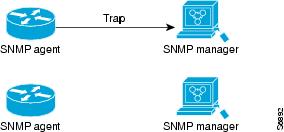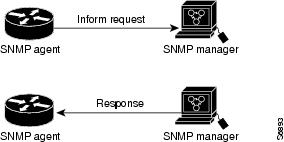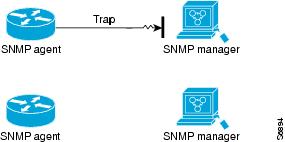SNMP Inform Requests
Description
The SNMP Inform Requests feature allows routers to send inform requests to SNMP managers.
Routers can send notifications to SNMP managers when particular events occur. For example, an agent router might send a message to a manager when the agent router experiences an error condition.
SNMP notifications can be sent as traps or inform requests. Traps are unreliable because the receiver does not send any acknowledgment when it receives a trap. The sender cannot determine if the trap was received. However, an SNMP manager that receives an inform
request acknowledges the message with an SNMP response PDU. If the manager does not receive an inform request, it does not send a response. If the sender never receives a response, the inform request can be sent again. Thus, informs are more likely to reach
their intended destination.
Because they are more reliable, informs consume more resources in the router and in the network. Unlike a trap, which is discarded as soon as it is sent, an inform request must be held in memory until a response is received or the request times out. Also, traps
are sent only once, while an inform may be retried several times. The retries increase traffic and contribute to a higher overhead on the network. Thus, traps and inform requests provide a trade-off between reliability and resources. If it is important that
the SNMP manager receives every notification, use inform requests. On the other hand, if you are concerned about traffic on your network or memory in the router and you do not need to receive every notification, use traps.
through illustrate
the differences between traps and inform requests.
In , the agent router successfully sends a trap to the SNMP manager. Although the manager receives the trap, it does not send
any acknowledgment to the agent. The agent has no way of knowing that the trap reached its destination.
Figure 1 Trap Sent to SNMP Manager Successfully

In , the agent router successfully sends an inform request to the manager. When the manager receives the inform request, it
sends a response back to the agent. Thus, the agent knows that the inform request successfully reached its destination. Notice that, in this example, twice as much traffic is generated as in ;
however, the agent is sure that the manager received the notification.
Figure 2 Inform Request Sent to SNMP Manager Successfully

In , the agent sends a trap to the manager, but the trap does not reach the manager. Since the agent has no way of knowing that
the trap did not reach its destination, the trap is not sent again. The manager never receives the trap.
Figure 3 Trap Unsuccessfully Sent to SNMP Manager

In , the agent sends an inform request to the manager, but the inform request does not reach the manager. Since the manager
did not receive the inform request, it does not send a response. After a period of time, the agent will resend the inform request. The second time, the manager receives the inform request and replies with a response. In this example, there is more traffic
than in ; however, the notification reaches the SNMP manager.
Figure 4 Inform Request Unsuccessfully Sent to SNMP Manager
